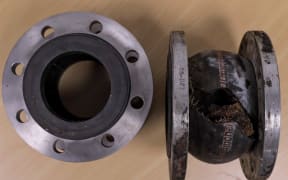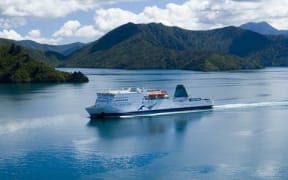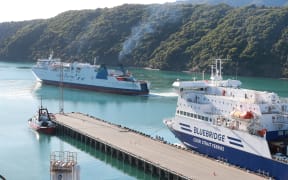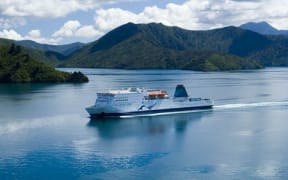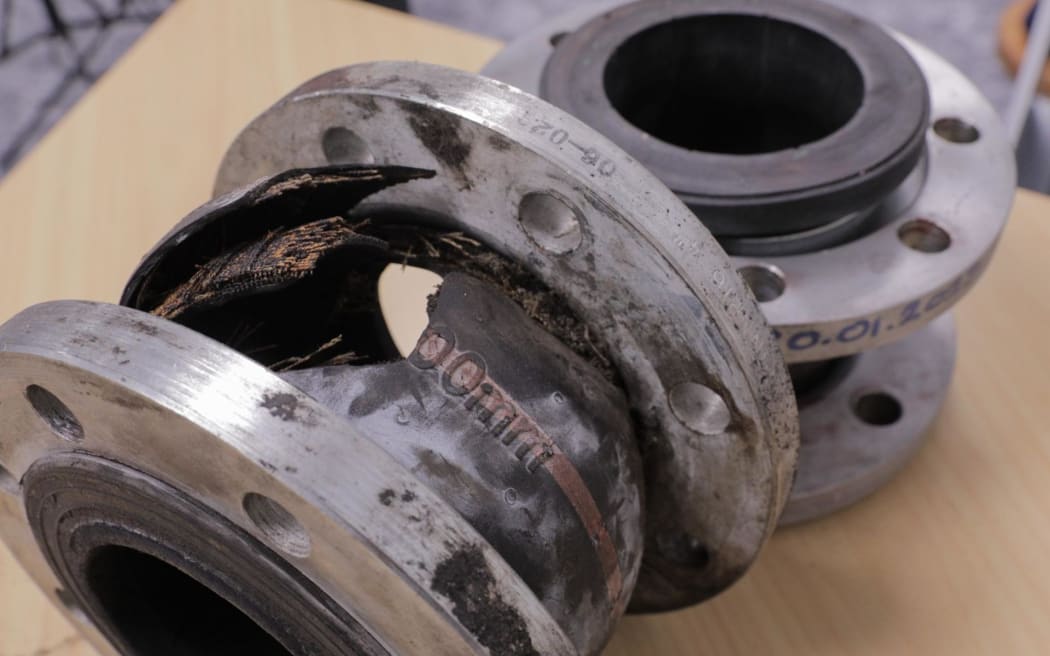
The rubber expansion joint that failed on the Kaitaki (foreground) was just one of the old parts in its engines a stocktake has revealed. Photo: Supplied
A stocktake of the Cook Strait ferries has found the Kaitaki had a lot of old parts in its engines when one blew out, casting the ship with 900 people adrift off the rocky south coast of Wellington in January.
Documents show three other rubber joints were as old or almost as old - and just as vital - as the one that blew out, getting mangled and shutting down the ferry's entire engine cooling system.
One had been manufactured in 2007, and kept in KiwiRail's stocks for 14 years. Then, under the safety regime KiwiRail was running just two years ago, it was installed, in 2021.
The ferry was left without engine power, adrift for an hour, as a rescue was scrambled, just 24 hours after the Auckland Anniversary Day floods.
The stocktake figures released to RNZ under the Official Information Act show more than half the 28 safety-critical rubber expansion joints (REJs) breached one best-by limit or another, but that these are changeable, and disputed, too.
The one that blew out in the Strait was made in 2005 but not installed in the Kaitaki's engines till 2018, and ruptured in January when it was 18 years old.
"The joint that deteriorated was too old and should never have been on our ship," KiwiRail told RNZ on Wednesday night.
However, the OIA shows two other joints on board were mirror images of the ruptured one, both 13 years old when they were installed, back in 2018.
Read here: KiwiRail's answer to the Official Information Act request
All of the ship's four main engines and two auxiliary engines relied upon the cooling system, which relies on the joints to keep water moving around.
The joints "begin to deteriorate from the date of manufacture", accident investigators said.
KiwiRail has pushed back. It had replaced all 28 critical REJs, stating on Tuesday to RNZ: "No cracking, delamination, or other such defects have been found" in them.
Interislander general manager of operations Duncan Roy acknowledged only two joints that were "found to have been over 14 years old" in the stocktake after January.
"These were in good condition at the time of replacement," Roy told RNZ on Wednesday.
But having such old joints on board would never happen again, he added.

The Transport Accident Investigation Commission's preliminary report into the Kaitaki was issued in May. Photo: Supplied
The Transport Accident Investigation Commission rushed out an interim report in May to alert shippers' to the dangers of old joints, accusing KiwiRail of ignoring manufacturers' guidance.
It said in May it was worried that other ferries in the fleet still had REJs on them that did not meet the manufacturer's guidance "and are at increased risk of failure".
But [https://www.nzherald.co.nz/nz/how-the-interislanders-kaitaki-ferry-narrowly-avoided-disaster/IBR3D3Q3KJD6FNJ6ABBH4P24VQ/
the dispute] - over just how long parts can hang around for, their shelf-life - continues even now, six months after passengers scrambled into lifejackets, with some saying later the Wahine disaster sprang to their minds.
RNZ asked for details of the stocktake's findings across all the ferries, but KiwiRail has so far provided only the Kaitaki's ones.
The Kaitaki findings were stark when judged against new, tighter best-by limits from either the commission or even KiwiRail itself.
RNZ's request for dates of when the 28 crucial joints (another 18 joints were not critical) were made, installed and replaced, returned stark results (out of 27 joints; for one, there was no data):
- 27 of 27 joints were installed more than eight months after manufacture (the commission's limit for shelf-life; KiwiRail has had a four-year limit since January)
- 25 out of 27 were more than four years old at install (beyond KiwiRail's new limit)
- The average age at install was five years
- Of the 14 joints manufactured before 2019, all were over four years old at time of install
- 16 out of 28 were found to have been in use for more than four years (KiwiRail's new limit is four years of use)
However, a sticking point remains over shelf-life, which leaves the ferry quality control regime partially in limbo.
KiwiRail decried the eight-month install limit as "a major departure from industry practice".
Maritime NZ has not expressly endorsed it, and the manufacturers' guidance is not straightforward.
Six manufacturers had provided guidelines, KiwiRail's OIA said. These varied a lot, from an install-by limit (shelf-life) of 18 months through to up to 10 years, for an average of six years; and a replace-by limit of 3-10 years (though three manufactures defined no limit).
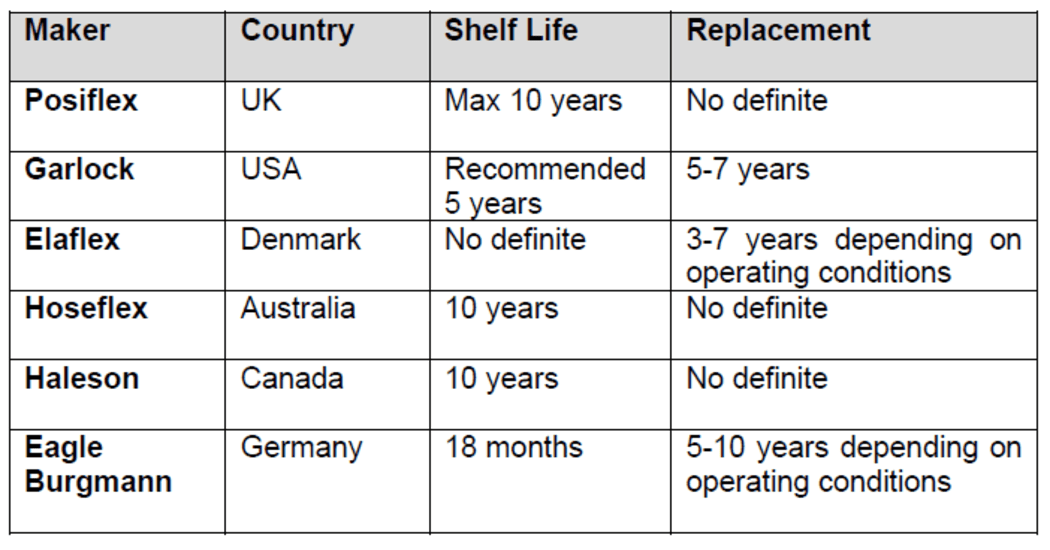
A table from KiwiRail indicating what various joint manufacturers told it were the install-by and replace-by limits. Photo: Supplied / KiwiRail
The commission lacks the power to enforce its tight limit - enforcement falls to Maritime NZ.
"In principle we support the recommendation, and we note that the storage time (eight months) related to a specific piece of equipment," Maritime NZ said on Wednesday.
It was referring to the old Eagle Burgmann REJ that ruptured. Nearly all Kaitaki's joints are from another manufacturer, Elaflex, and KiwiRail said it did not use Eagle Burgmann REJs anymore.
"The manufacturer is best placed to make recommendations," Maritime NZ said.
Duncan Roy said back in January there were no specific guidelines from manufacturers for the shelf life of REJs on ships in New Zealand.
They had now sought these from manufacturers.
"This now stipulates a maximum of four years in storage (from date of manufacture) and four years in use."
All REJs on all ships had been checked, critical ones replaced, and all other critical equipment audited.
"Our updated regime for tracking and maintaining such joints would prevent this from ever occurring again," he said.
"We are deeply sorry for the distress this incident may have caused."
TAIC said it was legally not able to comment.
Maritime NZ said it was undertaking work to clarify to operators their responsibilities to manage and maintain safety critical equipment.

